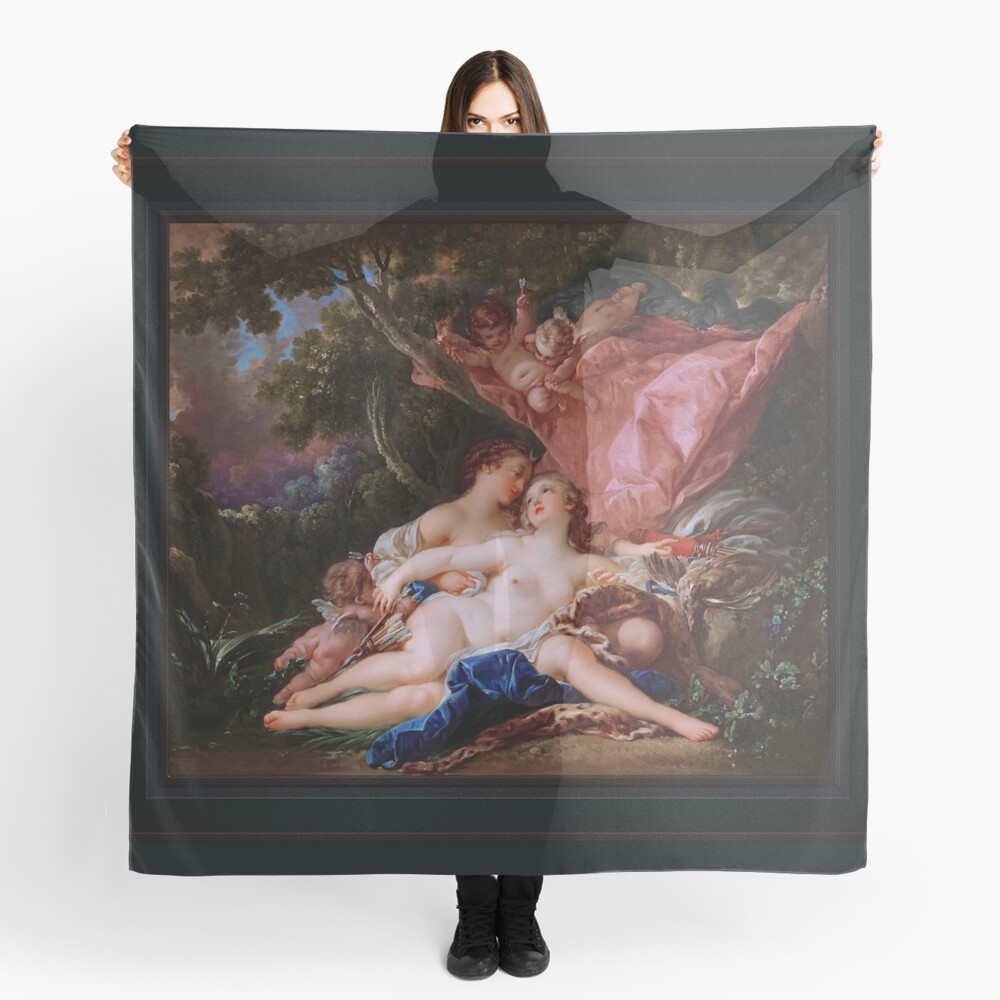
Jowisz w przebraniu Diany, and the Nymph Callisto
Jowisz w przebraniu Diany, and the Nymph Callisto c1759 by French Painter Francois Boucher (1703 – 1770); znany również jako rysownik, grawer i dekorator w stylu francuskiego rokoko, który był dobrze znany ze swojej bogatej mitologii, motywy alegoryczne i erotyczne, był nadwornym malarzem Ludwika XV i ulubieńcem markizy de Pompadour.

This is a beautiful scene depicting the characters from Roman mythology Jupiter (The Eagle), Diana (Goddess of the Hunt), and Callisto the favorite Nymph of Diana.
In this forest scene we can see six figures, two cherubs in a tree with a large rose drape hanging from one of its outstretched limbs, near the eagle Jupiter looking down on what appears to be Diana and her Nymph Callisto, with one holding an arrow in his left hand; with another on the ground by the pond that Diana and her Nymph Callisto are laying near with an arrow in its left hand and a quiver filled with arrows by its right side.
Jupiter, the King of the Gods taken by the beauty of Callisto, disguises himself as the huntress Diana to seduce her; embracing her while they relax by the pond on a cushion of leaves, a blue garment and leopard skin.
By the couple is a boulder that has on it a brown bird resting on the chest of light colored bird that has had its throat cut, with blood staining the rock.
Behind the birds is a red quiver filled with arrows and a bow and another wrapped up grey colored garment, that rest just under the pink drape and the eagle Jupiter.

In the background is a colorful forest of many different hues and a light blue sky filled with many colored clouds, that seems to be illuminated by a setting sun.
Jowisz w przebraniu Diany, and the Nymph Callisto is a remastered digital art old masters reproduction of a public domain image that is available as a druk na płótnie online.
Informacje poniżej pochodzą z Wikipedia.org
Pochodzący z Paryża, Boucher był synem mniej znanego malarza Nicolasa Bouchera, który dał mu pierwszy trening artystyczny. W wieku siedemnastu lat, obraz Bouchera podziwiał malarz François Lemoyne. Lemoyne mianował później Bouchera swoim uczniem, ale już po trzech miesiącach, poszedł do pracy dla grawera Jean-François Cars.
W 1720, zdobył elitarne Grand Prix de Rome za malarstwo, ale dopiero pięć lat później skorzystał z wynikającej z tego możliwości studiowania we Włoszech, z powodu problemów finansowych w Królewskiej Akademii Malarstwa i Rzeźby.[1] Po powrocie ze studiów we Włoszech został przyjęty do zrefundowanej Académie de peinture et de sculpture na 24 listopad 1731. Jego kawałek recepcji (kawałek recepcji) był jego Rinaldo i Armida z 1734.

Boucher poślubił Marie-Jeanne Buzeau w 1733. Para miała razem troje dzieci. Boucher został członkiem wydziału w 1734 i od tego momentu jego kariera nabrała tempa, gdy został mianowany profesorem, a następnie rektorem Akademii, zostaje inspektorem w Królewskiej Manufakturze Gobelinów i wreszcie premierem Peintre du Roi (Pierwszy malarz króla) w 1765. Portret Marie-Louise O'Murphy c. 1752
Boucher zmarł dnia 30 Móc 1770 w rodzinnym Paryżu. Jego imię, wraz z tym jego patronki Madame de Pompadour, stał się synonimem francuskiego stylu rokoko, prowadząc braci Goncourt do pisania: “Boucher jest jednym z tych mężczyzn, którzy reprezentują smak stulecia, kto wyraża?, personifikować i ucieleśniać go.”
Boucher słynie z tego, że mówi, że natura jest “zbyt zielony i słabo oświetlony” (zbyt zielony i źle oświetlony).
Boucher był związany z grawerem kamieni szlachetnych Jacques Guay, kogo nauczył rysować. Był również mentorem dla morawsko-austriackiego malarza Martina Ferdinanda Quadala oraz neoklasycznego malarza Jacquesa-Louisa Davida w 1767.[4] Później, Boucher wykonał serię rysunków dzieł Guay, które Madame de Pompadour następnie wygrawerowała i rozprowadziła jako ładnie oprawiony tom wśród uprzywilejowanych dworzan



